How Generative AI Could Change Search Behavior
Why reviewing your SEO strategy now can help prepare you for when Search Generative Experience (SGE) hits the mainstream.

Google releases several algorithm updates and layout changes to its search engine results page (SERP) every year. But no new tweaks will be bigger this year than Search Generative Experience (SGE), an AI/LLM-powered search engine that provides comprehensive answers to complex queries. SGE is primed to transform the traditional 1–10 blue links into more conversational experiences—but what does that mean for your SEO strategy?
To understand how to respond, let’s take a deep dive into what SGE is, how we think it will change search behavior, where we’ll see the most impact in the consumer journey, and what brands can do to prepare before SGE becomes widely available.
What is Google SGE?
Google’s Search Generative Experience rolled out in May 2023. SGE is not yet widely available, but anyone with a Google account can access SGE on their Chrome browser or Google app by joining the waitlist via Labs. Once access is granted, users are presented with an AI snapshot with answers to their queries. For example, a query for “tell me about hiking in the Catskills” generates a list of hiking trails, distances, and ideal hiking times, along with relevant links:
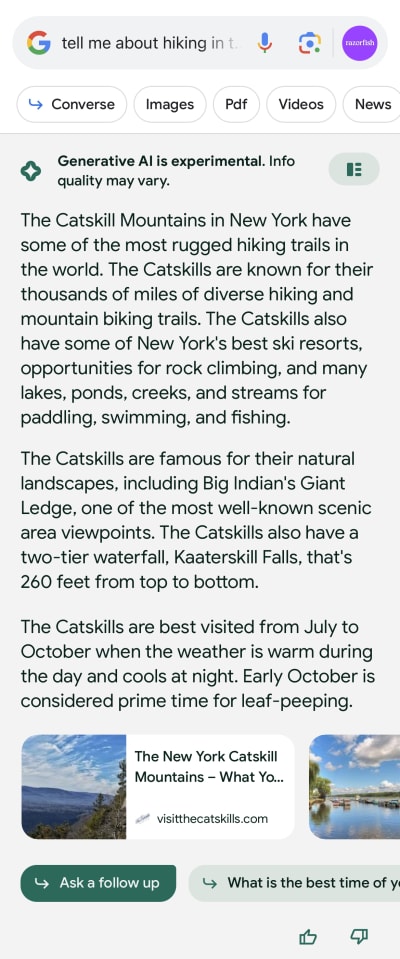
The “Ask a follow up” feature allows users to engage in a conversation. For example, “What should I wear for a hike in June?” returns a list of suggested gear.
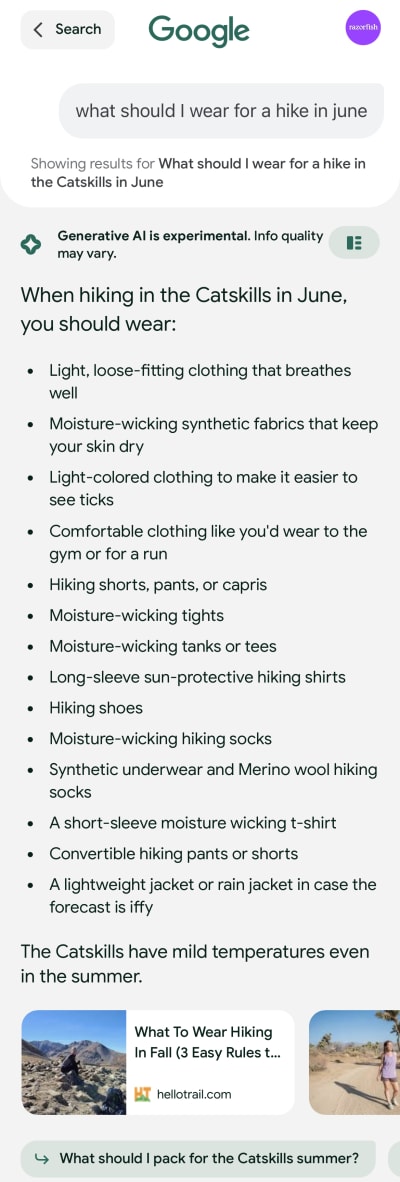
At the time of this publishing, generative AI snapshots are not available for all search queries. Brand terms like “Amazon,” recipes, NSFW content, current events, sensitive topics, and searches related to YMYL (your money, your life) categories are all query types that don’t yield SGE results, or limits results with certain conversational modifiers. A generic search for the diabetes drug Ozempic, for example, fails to return an AI snapshot:
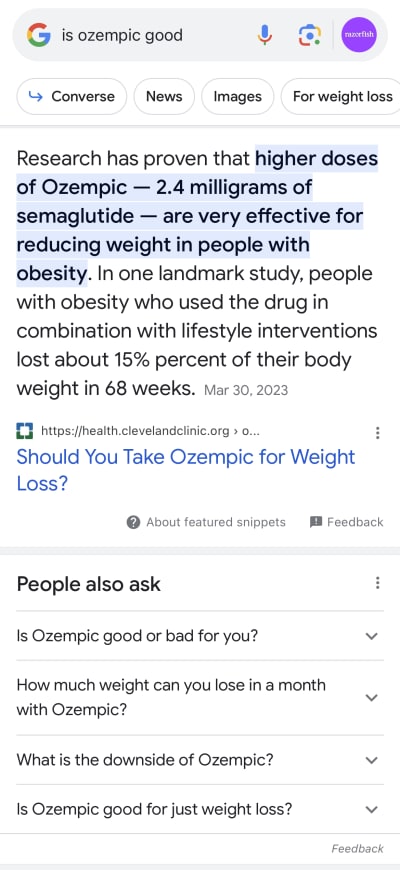
However, when a search modifier is added such as “for you” or “for weight loss,” additional information is returned:

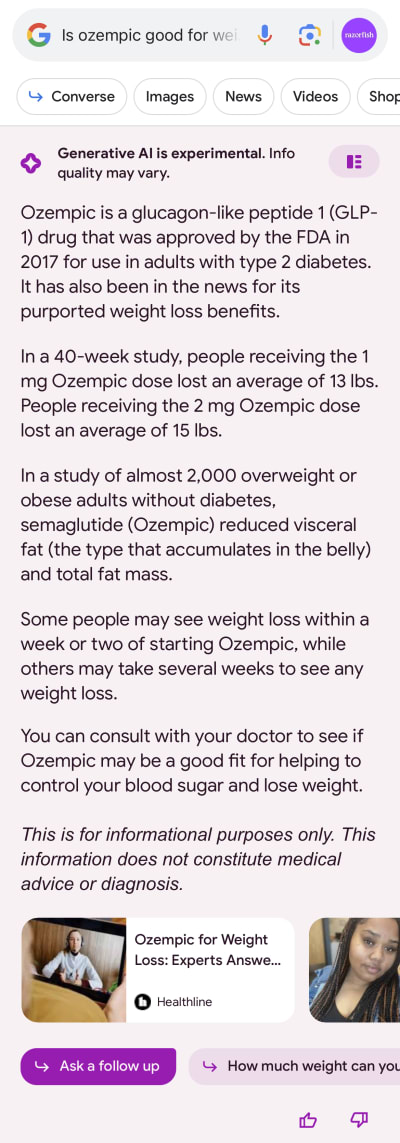
How are people searching on Google SGE?
While SGE is relatively new, we can look to the past to help predict how this new capability may influence future search behavior. Before 2015 and the advancement of Google as a hyperlocal discovery engine, “near me” searches were almost non-existent. Now, “near me” searches are some of the most popular queries on Google, just behind “how to” and “what is.”
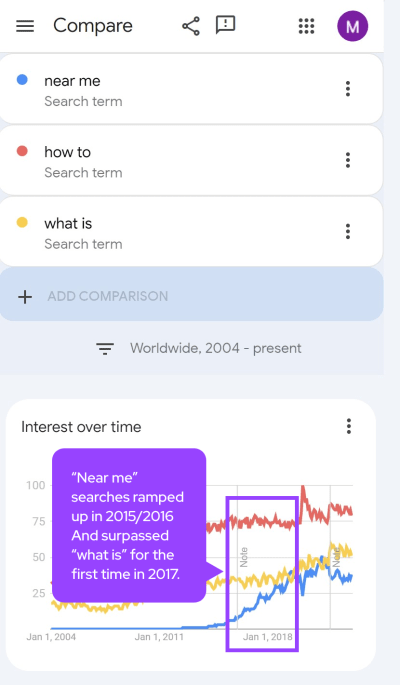
With the ability of AI to further help consumers recommend products, complete tasks, plan itineraries, and organize information, we are predicting the following modifiers will become more common, just as “near me” did almost a decade ago:
-
Help me: As AI becomes more adept at assisting with various tasks—whether that’s solving a math problem or planning a trip to Bora Bora—we expect users to seek help through search engines more frequently.
-
Find me: Today, people search “near me” when they’re looking for dinner options and then review the list of recommendations near their location. Tomorrow, people may want Google to find locations with ultra-specific criteria, such as a tapas restaurant that has $10 Aperol spritzes and allows dogs on the patio, or products such as a kayak that can withstand 10-foot waves.
-
Show me: These modifiers might be directed at Google when a user needs to see how to work something out in a visual way, such as a complex math problem or an edit to a line of code.
-
Who/What/When/Where/
Why/How do I: “How to” and “what is” are already leading modifiers for people using Google. Shifting to more conversational and personalized queries is a natural evolution for people looking for quick facts or how to do something quickly. -
Please: This is partly a joke, but manners do matter, even with generative AI. Many people may look at these tools as digital assistants and begin layering basic social cues—such as “please” and “thank you”—which acknowledges our innate nature as humans to look at AI engines as digital assistants.
Where we'll see the most impact
The research phase of the consumer journey is where we believe we will see the biggest transformation due to AI. Google’s SGE aims to keep consumers engaged throughout their journey. Prior to SGE, slightly more than half of shoppers already used Google for research purposes.
While it’s too soon to say how SGE will impact time spent making a purchase, finalizing plans, or learning about a topic in depth via Google, we do have some early stats from Bing’s OpenAI chatbot that may foreshadow future changes:
-
35% of Bing AI-powered chat queries are either retail/shopping or travel related
-
Average generative AI chat queries are 3x longer than the average traditional search query
-
AI-enabled chat experiences are 66% longer than the traditional search process
What AI-powered SGE means for SEO, and how brands can adapt
For the time being, the fundamentals of SEO remain unchanged. Brands should continue to prioritize technical accessibility, trustworthy content, and relevance to ensure your site appears as a top result.
Currently, there is no “optimizing for AI” and the same factors that are being used to rank websites are still at play. But we could see more niche content appearing in SGE results that is hyper-relevant to where a consumer is in their journey. We’re also likely to see more demand for multi-formatted content—pages that incorporate text, videos, imagery, and rich markup—that can fuel AI results.
Due to its limited rollout, we have yet to see how AI will impact site traffic, but following these best practices will help brands have a better chance of maintaining their SEO performance as SGE becomes the standard:
-
Ensure your on-page elements are optimized. Meta page titles, meta descriptions, header tags, and other page elements should all follow SEO best practices.
-
Fix broken structured data. We anticipate that structured data will continue to evolve and will carry more weight. Test your structured data and fix what’s broken. You can even test structured data code within SGE to see what’s wrong and how to fix it.
-
Optimize visual assets. Google showed that its AI is going to be visual, which makes it crucial that your site images can be found. Ensure images have alt text, are not too large, and are appropriately placed in your structured data. Make sure you don’t have any hidden imagery.
-
Build a list of queries that you think might be the most impacted by AI and begin tracking them. Monitor a mix of head and long-tail terms, and create new modifiers to track more conversational terms. How does your site rank change with respect to these terms? Are you appearing multiple times (in AI and in the traditional results)?
-
Identify opportunities. If you have keywords that you aren’t currently in the top results for but are on the cusp of, consider prioritizing those as quick-win opportunities. Create more relevant content around supporting topics to help your page rise to the top and give you a better shot at appearing in AI answers.
-
Monitor traffic. Formulate a list of questions to help analyze site traffic. How much of your site traffic is from search? Do you see shifts—good or bad—in that traffic? Are there changes in your top landing pages? What are the commonalities in those changes? Are they being served in AI chat boxes?
The impact on paid ads
Search engine marketing has seen minimal impact on Google’s Search Generative Experience and AI-powered snapshots. Paid search listings are alive and well, retaining their current placement in the search results ahead of AI-powered snapshots and pushing the traditional organic listings farther down the page. Whether that has an impact on the number of users ignoring paid ads (70–80%) has yet to be determined.
For paid search listings in AI-powered snapshots, Google is expected to use this ad space to show highly-targeted ads while a user is deep in a conversation. Google even announced that it will eventually start to write ads in real time based on the context of the conversation. If Google is able to execute this feature, it could lead to a step-level change in both clickthrough rates and conversion rates. In this case, Google will be able to demand a premium for this inventory and many advertisers are likely to pay if it can deliver stronger ROI.
The takeaway
AI-powered search experiences will significantly change how people search but won’t change why people search. While the format and way people interact with search engines will evolve, strong and credible content on a user-friendly site will continue to provide a competitive advantage when it comes to SGE.
If you have any questions about how to ensure your site is prepared to appear in Google’s new search generative experience, reach out to seo@razorfish.com.


